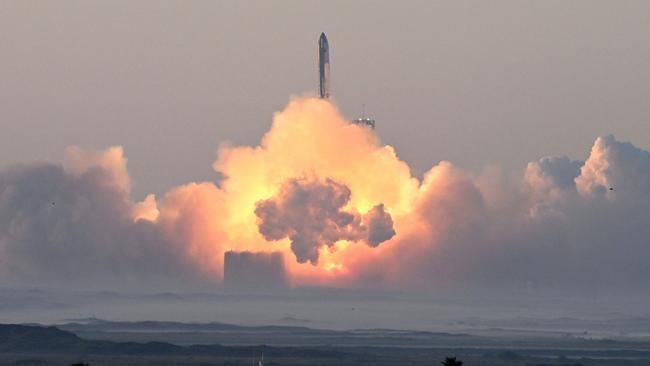Starship test flies longer — and ends with another explosion
Elon Musk’s deep-space rocket achieved separation before contact with the spacecraft was lost.

Spaces’s second test flight of its massive Starship rocket ended early Saturday when the uncrewed vehicle’s spacecraft blew up, though the launch made it farther than the company’s previous attempt.
Spaces said it lost contact with the Starship spacecraft about 15 minutes after launching from the company’s spaceport east of Brownsville, Texas, around 8am. A self-destruct mechanism appeared to trigger after contact was lost, exploding the craft, according to a SpaceX livestream.
SpaceX engineers said on the livestream that Saturday’s test-flight showed progress for the rocket that Elon Musk, the company’s chief executive, wants to use for deep-space missions.
“With a test like this, success comes from what we learn, and today’s test will help us improve Starship’s reliability as SpaceX seeks to make life multiplanetary,” the company said on X, formerly known as Twitter, not long after the end of the flight. Musk later reposted a photograph that included him in the Starship launch-control room, as well as photographs of the mission.
The Federal Aviation Administration said there were no reports of injuries or property damage from the launch. The agency will take part in a mishap investigation, the results of which will determine when SpaceX can pursue another launch.
The flight was intended to be a roughly 90-minute operation. About 3 minutes after launch, the Starship spacecraft separated from a huge booster and began to ascend on its own, according to a company livestream.
Separation between the booster rocket and the spacecraft that sat on top of it at liftoff was a key goal for SpaceX for Saturday’s flight. During the inaugural demonstration mission in April, the separation didn’t occur, and a system on the rocket blew up the vehicle.
SpaceX used a new method Saturday to perform the separation. Called “hot staging,” the engines on the spacecraft began to fire away while that vehicle was still attached to the booster that powered the combined vehicle off the launchpad.
“We got the hot staging, you know, the thing that we really wanted to see,” said John Insprucker, a SpaceX engineer and commentator during the company’s livestream. “We saw the separation.”
The flight path had called for the spacecraft to power toward space and travel around the planet before landing in the Pacific Ocean near Hawaii. Jonathan McDowell, an astrophysicist who closely tracks space activities, calculated that the vehicle made it to space, reaching a peak altitude of 93 miles above the Earth.
Musk and SpaceX have much riding on Starship. NASA is counting on the vehicle to ferry astronauts to the moon’s surface as part of its Artemis exploration program, and Musk has touted Starship as humanity’s eventual ticket to Mars.
The vehicle, which stands close to 400 feet tall when stacked up, consists of a booster called Super Heavy that is designed to blast a spacecraft into orbit. The company calls Starship the most powerful rocket ever built.
After 10 million pounds of fuel were loaded into both stages of the rocket, the combined vehicle roared off a launchpad Saturday, drawing cheers from SpaceX employees who had gathered to view the flight from the company’s headquarters in Hawthorne, Calif.
The 33 engines on the booster functioned as designed, according to the SpaceX livestream. The vehicle also made it through a period during ascent of intense stress before completing the separation manoeuvre. Right after separation, the booster exploded over the Gulf of Mexico.
Starship’s inaugural test flight in April ended about 4 minutes after liftoff, when it exploded over the Gulf of Mexico. Leaking fuel during ascent severed the connection to that vehicle’s main flight computer, and the company lost control of the rocket. Engines went out. A safety system later blew up that Starship as it tumbled in the air.
Musk had warned ahead of time about that flight’s potential for failure, and said afterward the company learned a lot from the attempt. He has said SpaceX made more than 1,000 changes related to Starship following the first mission.
SpaceX has long used what company executives have described as an iterative approach to developing, testing and improving rockets and spacecraft. That style has generated a number of explosions during tests over the years.
At Starbase, the company’s Texas spaceport, the company has installed a water-deluge system at the launchpad to damp the intense power of the 33 engines on the Starship booster at liftoff, and avoid spreading debris. April’s test flight sent chunks of concrete and other debris across hundreds of acres of land and ignited a 3.5-acre fire, drawing objections from environmentalists.
Executives at SpaceX have said that the company needs to fly Starship many times before it carries any people. SpaceX still has significant technical hurdles to overcome with Starship, including showing that it can use a tanker variant to transfer fuel to ships in orbit.
SpaceX has broader plans for Starship — not least of which is the Mars mission that has long animated Musk’s activities with space. It plans to use Starship to blast upgraded versions of its Starlink satellites into orbit and conduct missions for customers besides NASA, including private space travelers.
Doug Cameron contributed to this article.
The Wall Street Journal



To join the conversation, please log in. Don't have an account? Register
Join the conversation, you are commenting as Logout